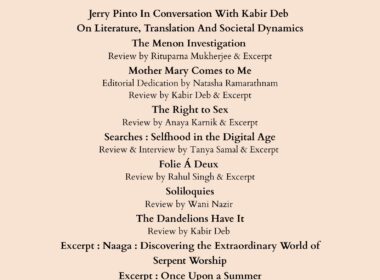The Right to Sex
By Anaya Karnik

Image Courtesy of Bloomsbury Publishing
In her 2021 publication, The Right to Sex, Amia Srinivasan discusses feminism in the 21st century. This particular collection of six essays address what “many men and women already know”(Srinivasan xvii). Her essays claim to draw on an older feminist tradition. According to Srinivasan, this feminist tradition was “unafraid to think of sex as a political phenomenon.”(Srinivasan xv) She reflects on the feminist tradition that women such as Simone de Beauvoir, Alexandra Kollontai, Bell Hooks, Audre Lorde, Catherine MacKinnon, and Adrienne Rich advocated.
These six essays shed light on the politics and ethics of sex and offer hope for a better future. Srinivasan begins by explaining the difference between sex, which is assigned at birth, and sex as a physical act. She explains how sex, a physical act, is closely linked to an agency as well as oppression. Through her writing, she aims to shed light on freedom of sex, especially for women. She proposes the idea that sex as a natural phenomenon is a misconception; rather, it has been shaped by patriarchy. Srinivasan attempts to see the world through contemporary feminist concerns, with perfect examples of bold, modern pieces of work which aim to tackle the ongoing issues in the most effective ways possible.
In the first essay titled The Conspiracy Against Men she speaks about the ‘hysteria’(Srinivasan 1) of fake rape allegations and the harm that malicious women draw against innocent men who then get falsely accused. Srinivasan puts forward the idea that the actual source of this hysteria is not rooted in statistical reality but in the fear of men that they will lose their right to sex. She acknowledges the fact that some men do get falsely accused of rape, but such cases are rare and far less than the cases in which actual rape takes place, and no justice is served, especially against women. Srinivasan speaks about how racism impacts false rape accusations. She points out how these accusations have been weaponised to target marginalised men, particularly black men, which in turn maintains their oppression through legal institutions.
Then, she interrogates the #Metoo movement and how it becomes essential in gaining justice for the victims of sexual crimes and draws attention to how race, class, and social status shape both the believed and accused, reminding readers that the act of institutional reform can end up perpetuating the same social inequalities it was meant to address, if these factors go unexamined. Srinivasan breaks down simplistic narratives about sexual violence and false accusations, arguing for a feminist politics that is conscious of intersectionality and the dangers of carceral feminism while also rejecting the notion that there is a widespread controversy against men. Her essay particularly stands out as it speaks volumes for the contemporary feminist concerns and exposes the sources of injustice that are often overlooked or deliberately ignored.
In the second essay of her book, titled Talking to My Students about Porn, she begins by speaking about the porn wars in the 1970s and 1980s, and about the debate between anti-porn feminists and pro-porn feminists. The pro-porn feminists saw an opportunity for liberation and sexual freedom, whereas the anti-porn feminists saw porn as a primary tool of patriarchal oppression and believed that pornography is directly linked to sexual violence in the real world. This idea was put forward through slogans like “Porn is theory, Rape is practice.”
She speaks about the classroom discussions she had with her students about pornography and acknowledges that porn often reinforces misogynistic and homogenised tropes. Her discussions with the students reveal that feminist and queer porn do offer an alternative, but it is often not accessible to people because of socio-economic barriers, while also highlighting the fact that pornography of this kind often gets banned, rather than the mainstream stereotyped pornography that is governed by patriarchy. She links it to Laura Mulvey’s essay Visual Pleasure and Narrative Cinema (1975) and how women are often depicted as the object of desire and men as the ones who desire them.
Mainstream pornography reinforces the fact that patriarchal structures make the world believe that women are merely objects of desire and do not possess a desire of their own. Srinivasan does not offer a simple or definitive solution; instead, she approaches educators and students to look at porn critically, treating it as a cultural text that deserves the same scrutiny as literature or media. Her essay provides us with tools to critically engage and think about pornography and sexual politics.
Moving forward to her third essay, which is also where the book gets its title from, The Right to Sex, Srinivasan critically examines the ethical, political, and social dimensions of sexual desire, consent, and sexual entitlement within contemporary feminism. She argues that consent alone is not enough to ensure an ethical sexual encounter, and power dynamics such as age, race, and gender are essential in understanding true agency in sexual relationships. She urges the readers to not just acknowledge the presence of consent but the driving forces behind it.
She also addresses sexual hierarchy, which is one of the major themes of the book. It sheds light upon how sexual desirability confers social status and is determined by racialised, gendered, and ableist norms. She urges the readers to think about the broader ideas of the world, which are wrapped around systematic inequalities such as capitalism, racism, and patriarchy, and how they are linked to
sexual desire and fulfillment. Srinivasan emphasises intersectionality, showing how sexual justice must centre marginalised experiences and dismantle systems that perpetuate violence and discrimination. Her vision of sexual justice includes not only the right to consensual pleasure but also the challenge to existing social hierarchies and the transformation of desire itself. This essay provokes readers to reconsider what sexual liberation looks like, refuses easy answers, and calls for a deeper ethical inquiry, social transformation, and justice at the intersection of desire, consent, and power.
In the next essay of the book, Coda: The Politics of Desire, which is an addendum to her previous essay, Srinivasan points out that desire is intricately shaped by socio-political aspects of the world. She suggests that desire is never completely personal or ‘natural’ as it is considered, but is driven by systems of oppression, including racism, patriarchy, ableism, and classism. She explores how individuals unconsciously internalise social hierarchies of ‘desirability,’ such that desires reflect the existing power structures instead of challenging them.
One of the key arguments of this essay is to treat sexual preferences as fixed or ‘pre-political’ to give a free pass to discrimination and exclusion. The coda ultimately debates whether the transformation of desire should be a moralistic, disciplinary project or an emancipatory one. This part of the essay challenges the readers to rethink their desires, both acknowledging their roots in oppressive systems and imagining the possibility of freeing desire from the grip of the structures that rule our minds, pushing for political transformation at the intersection of sexuality, identity, and justice.
Further, Srinivasan, in her fifth essay of the book, speaks about the ethics, power dynamics, and social consequences of sexual and romantic encounters between professors and students, which go beyond the typical notion of consent. In On Not Sleeping with Your Students, Srinivasan first acknowledges the familiar case against professor-student relationships. She throws light upon the inherent power difference and the risk of coercion, especially in the context of grades and career advancement. However, her central argument is rooted in the ethics of teaching itself. She contends that such relationships are a pedagogical failure because a teacher’s core responsibility is to nurture the student’s desire for knowledge and intellectual growth, not redirect that desire toward themselves as an object of romantic or sexual longing.
By drawing Freud’s theory of transference, she argues that teachers, like therapists, are responsible for not exploiting this transference for personal gratification, and also highlights how these relationships are often gendered, typically involving male professors and female students, raising broader concerns about patriarchy and societal expectations. She also points out that during the rise of genuine romantic feelings, consent cannot be taken at its face value as the student may feel a pressure to say ‘yes’ because of the power dynamic and may be afraid to say ‘no’ since the consequences would have taken a toll on their confidence. In this essay, Srinivasan calls for universities to rethink their policies and expectations from the faculty, emphasising that a truly ethical teacher-student relationship should put students growth first and protect them against both systemic and personal forms of exploitation, which mostly affect women.
In the final essay of the book, Sex, Carceralism, Capitalism, Srinivasan critiques how feminist movements, government policy, and capitalist forces intersect and shape sexual politics, often with unintended consequences for the most marginalized. She discusses “carceral feminism” (Srinivasan 132) as an approach to addressing sexual violence and misogyny that heavily depends on stronger laws, increased policing, and harsher punishments. She argues that this strategy often ends up disproportionately harming working-class women, racialised communities, and sex workers by reinforcing state violence and social exclusion, even though it intends to protect them. The essay also interrogates the societal focus on consent as the measure of moral sex, suggesting that this parallels capitalist ideas about ‘free exchange’, where the conditions that produce sexual choices and desires are ignored. Srinivasan warns the readers that consent-based frameworks often overlook how class, race, and other hierarchies shape “choices,” justifying inequality in sexual and economic domains. Furthermore, she also points out how mainstream porn often propagates patriarchal sexual fantasies, root problems in desire and sexual power, and how legal battles often fail to disrupt capitalist and patriarchal logic. Her final essay is a plea to rethink how feminism, law, and capitalism interact to produce and police sexual subjectivity. She insists on making new paths toward liberation, solidarity, and lasting justice for all.
Amia Srinivasan is the Chichele Professor of Social and Political Theory at All Souls College, Oxford and a contributing editor at the LRB. Her first book, The Right to Sex: Feminism in the 21st Century, was published in 2021. The title essay was first published in the LRB as ‘Does anyone have the right to sex?’ She’s also written for the paper on subjects including free speech on campus, pronouns, octopuses, bestiality and sharks.

Image Courtesy of Bloomsbury Publishing
Anaya Karnik is a writer and postgraduate student of English Literature at SNDT University, Mumbai. Her academic interests lie in feminist literary criticism and contemporary cultural studies. A graduate of Wilson College, where she served as Student Editor of The Wilsonian, the annual college magazine, brings a thoughtful eye to both creative and critical writing. When she’s not buried in books, she’s usually writing about them, questioning, interpreting, and celebrating the power of language.




